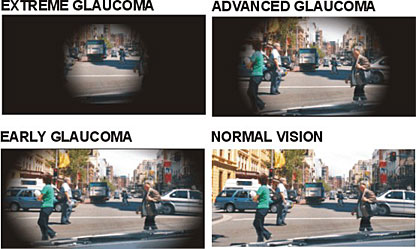|
GlaucomaLeading Cause of Irreversible Blindnessage-well.org > eye care > glaucoma by Michelle Botes Glaucoma is considered to be the world’s leading cause of irreversible blindness, yet so few sufferers are aware that they have the disease. What makes this condition so difficult to detect is the lack of any early warning signs or symptoms. Once the first visible symptoms occur, there is already serious damage done to the eyes optic nerves. What is Glaucoma?Plainly put, this condition is caused by the buildup of intraocular eye pressure. The eye is equipped with a complex drainage system and when a malfunction or blockage occurs in this drainage system, it causes fluid buildup or intraocular pressure (IOP). If left untreated, this buildup causes serious and irreversible damage to the eyes’ optic nerve. Signs and SymptomsThis disease builds up over a period of time and the lack of warning signs at the onset makes detection difficult. If left untreated, a sufferer will slowly lose their peripheral vision. In certain types of the illness, symptoms such as blurry vision, halo’s around lights, nausea and vomiting might occur. Regular eye exams are extremely important in the detection and effective treatment, especially if you fall in any of the following categories:
How Vision Looks In Different Stages

Types and Treatment Open angle glaucoma, also known as chronic open angle or primary open angle. This is the most common form of the diseases. The intraocular pressure is built up over a long period of time and the sufferer gradually looses his/her peripheral vision. Treatment usually includes eye drops to decrease the pressure or surgery in extreme cases. Acute angle closure glaucoma, also known as closed angle or narrow angle, occurs when the iris (coloured part of eye) is suddenly pushed forward, causing a blockage. In this case the patient does experience a quick onset of symptoms such as headache, red eyes, eye pain, halo’s around lights, nausea and vomiting. With each occurrence of this form of the disease damage is done to the optic nerves. The pressure should be relieved by a medical professional as soon as possible in order to limit the damage to the optical nerve. Treatment could include oral medication and eye drops. Secondary glaucoma usually occurs due to underlying factors such as diabetes, injury to the eye, cataracts or tumors. In this case, both the eye condition and the underlying disease or cause should be treated. Treatment includes eye drops and in some instances surgery might be required. Congenital glaucoma, also known as infantile glaucoma. This is a hereditary condition occurring in young children. If detected and treated early enough, a child’s sight might be preserved. Treatment may include medication and often, surgery. Diagnosis and DetectionThe importance of regular eye exams cannot be emphasized enough, especially in the detection of the condition where symptoms are not present. Your eye care specialist can do a series of tests, all of them painless, to determine the presence of the disease. Tonometry: Your eye care specialist tests your eye to determine the intraocular pressure (IOP). There are many ways in which this test can be done, the two most popular tests are done with either a tonometer that blows a puff of wind onto the eye that measures your IOP or your eye is numbed with eye drops and a tonometer is placed against the front of the eye to measure your IOP. Gonioscopy: Your eye care specialist will numb the eye with anesthetic drops and place an instrument with mirrors on the surface on your eyeball. This instrument allows him/her to inspect the eyes drainage system from several angles. Visual field testing: This test is performed to determine the loss of peripheral vision over a period of time. The patient is required to focus their eyes straight ahead and respond whenever he/she notices a flashing light in their peripheral vision. This test is conducted with regular intervals to determine the rate of loss of sight. There are no known prevention measures that one can take to prevent this disease from occurring. Medici often refers to this disease as the ‘silent sight thief’, due to no signs or symptoms being present in most cases. However, regular eye exams could aid in early detection and effective treatment, limiting the damage and effect this disease has. Eyesight is extremely valuable and should not be neglected or taken for granted. Get tested!
Sources age-well.org > eye care > glaucoma TOP of Glaucoma |
Translate this Site

Search this Site
Care For Your Eyes
List of Eye Conditions
Subscribe to Our E-NewsOther Conditions
Develop Smart Habits
|
|||||||||||||||||||||||||||||||||||||||||||||||||||||
|
|
|||||||||||||||||||||||||||||||||||||||||||||||||||||






